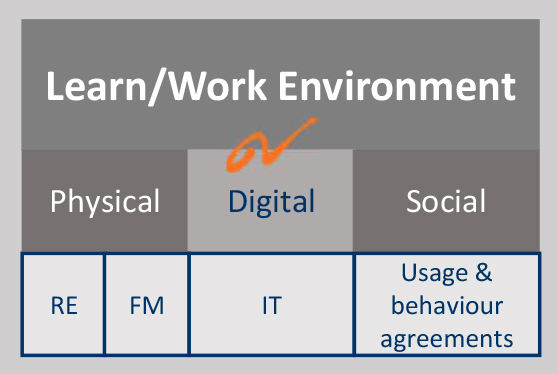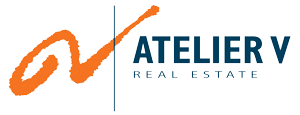
Manageability-Governance
This is the fourth main sub-question to answer ‘Is the learn/work environment adding value?’ What do you need as proof of regulatory reporting and success? The learn/work environment is an ecosystem to support people. Therefore it should be managed integrally and interdisciplinary with an evidence-based value add approach. (Big) data is the leverage to make well-informed decisions, validate interventions and be accountable.
Close cooperation of the departments of Real Estate, Facilities Management, Information Technology and Human Resources makes sense to avoid silo thinking and deliver seamless services to the occupants. Besides that, integrating diversity has the potential for innovation. These departments are key enablers for an excellent learn/work environment to let the organisation and its people thrive. Integrated management is expected to ensure that every unit has systems and processes in place to verify the quality of the performance of tasks and compliance with legal, health and safety regulations, mitigation of potential risks and improve customer service experiences.
A manager’s implicit trust alone is not enough because freedom comes with responsibility. And, that’s why it’s helpful to explicitly make clear agreements and unambiguous statements on mutual expectations between managers and team members. The number of agreements should be defined by the output and tangible results you’re aiming for, and less about the process of how to get there. Make them as transparent and as simple as possible to foster trust within the team. Check regularly if the existing approach is still in line with the chosen strategy or needs adjustments.
Do we know what the outcomes are that matter to employer and to employees?
How do we assess the outcome?
Does the learn/work environment meet the demand and expectations now and in the near future? Is it adaptive to changing user needs? Is it accounting and regulatory compliance? Are the occupancy costs and performances, affordable, accountable and transparent? Does the ecological footprint and future (re)usability match the sustainability ambitions? Are the human and social capital strategies defined, tracked and measured?
Every organisation – public, private or non-profit – needs evidence to make decisions about performance. It helps to provide insight and transparency about the strategic direction of the organisation, and in which direction decisions must be made and their financial implications. Offer this in a simple format and as frequently as possible to ensure the information is current as well as easy to absorb.
An organisation is not static. It must anticipate change and adapt as customer demands evolve through technological developments, as peoples’ expectations for convenient services grow, and as individuals demand learning/workplaces where they can be at their most productive and where the impact we have on the environment is sustainable.
Lead with evidence
Both building owners and users have a responsibility for a safe, environmentally responsible and energy-efficient building. Management models and contingency plans are aimed at controlling the risks for the organisation and providing reasonable (but not absolute) assurance about the effectiveness, efficiency health & safety and legality of the performance of duties.
Unforeseen circumstances can always arise and some residual risks remain. This recognition is an important element in risk management, which is part of integrated management and focuses on reducing, avoiding and insuring risks, but also accepting residual risks. Risks are made transparent by means of periodic information provision and decision-making.
The three main risk elements in learn/work environments that are reported on are Money, Time and Quality. Also in this order where Quality is often underexposed! Quality is here used in the sense of fit-for-purpose. The right location, enough floor space that is functional, technical and aesthetically adequate for the intended use.

An environment that supports the health and well-being of people. The condition of the learn/work environment enhances lives, enables success, ensures value, and can improve the recruitment and retention of talented people.
Technical quality is about the (maintenance of the) condition of the building and its installations so that they continue to match the needs of the primary processes and the corporate identity.
A whole-life asset management approach to maintenance can build value, reduce liabilities, and ensure the longevity of the learn/work environment.

“Real Estate, Facility Management and IT are in charge of the lawn, the services and the maintenance of it. Human Resources is in charge of how people behave and feel on the lawn.” (René Stevens)

Real Estate & Facility Management (RE&FM) and Information Technology (IT) in collaboration with Human Resources (HR) form a ‘duet-for-three-hands’. This gives a focus on the environment in which people must function and perform.
It creates a holistic symbiosis between the learn/work environment, the organisational objectives and the humans inside this eco-system. This synergy will unlock the latent potential for innovation, growth, health, well-being and consciousness of an organisation and its people.

Measuring the contribution of the learn/work environment to the strategic policy objectives provides additional management information for prioritisation when allocating (limited) budgets. In addition to the ‘accountants’ approach, it provides input for a more holistic and integrated business assessment of how to optimize the learn/work environment. Be aware that performance is a result of pursuing something worthwhile, not a goal in its own right.
“When the facts become clear, our choices become obvious.”
A negative influence on the health and well-being of people is another important risk factor to consider. Because the built environment has the ability to influence us for the best or the worst; we spend more than 90% of our time inside buildings. The new science of Epigenetics has taught us that our environment is the number one influencer of our health and well-being.
The ultimate test for the effectiveness of the learn/work environment is the satisfaction and experience of those who use it. Apart from the (subjective) opinion of the users, there is also a need for an objective assessment of whether the intended effect of the study/workplace is realized in an efficient manner on time, within budget and with acceptable risks. Embracing a fusion of subjective user opinions and objective assessments, rather than polarizing them.
We use the eight constraints of a project, Scope, Time, Risk, Experience, Resources, Information, Cost and Quality (STRERICQ). These aspects are made SMARTI, coordinated and integrated into one approach because they are all inseparable parts of the whole learn/work environment.
- TIME: By when, and for how long, should the outcome be delivered?
- RISK: What can go wrong, and what can be done about it to mitigate or avoid it?
- RESOURCES: Who and What is Where required to do the work? Which capacity and competence are required for managing the required objectives and expectations?
- INFORMATION: What are the relevant measurements to report for informed decision-making?
This makes iterative learning through transparent monitoring, adjustment and feedback communication possible. It focuses on the measurement process and progress rather than the results. It is more about continuous learning and communication than control, identifying problems and assigning errors.
Analytical thinking allows us to comprehend the parts of the learn/work environment while integrated thinking enables us to understand how they work together.

Quality assurance system
The organisation’s management model aims at managing the risks for the institution and to provide reasonable (but not absolute) assurance of effectiveness, efficiency and legality of the performance of tasks. Unforeseen circumstances can always arise. This recognition is an important element in risk management, which forms part of integral management and is aimed at reducing, avoiding and insuring risks, but also accepting residual risks.
Risk management is not an end in itself, but a body of thought that makes it possible to explicitly gain more insight and awareness to the extent that the organisational objectives are met. Therefore risk management must be integrally and explicitly incorporated into the existing planning & control cycle.
This means that risks are widely identified and addressed in the organisation. A quality assurance system takes care that the operational risks and control measures are anchored in the operational going-concern processes. Maintenance choices need to account for where building components are in their lifecycle (8 layers of change) and target investment accordingly.
The quality of education, research and facilities stands and falls with the quality of the employees. The quality of the employees being not sufficient is a risk in itself. Besides the physical en digital learn/work environment, also the social learn/work environment is an important part of the quality assurance system.
The periodic Human Resource (HR) performance review pays attention to the performance of the employees, but little or no attention to the environment in which they have to perform. A questionnaire about the learn/work environment in combination with the periodic HR performance interview offers opportunities to attract, better facilitate and retain employees.

The Real Estate GPS offers smart systematic data collection based on the eight constraints of a project: Scope, Time, Resources, Experience, Risk, Information, Cost, and Quality (STRERICQ). For a periodic 360° feedback survey of the learn/work environment to unlock potential and formulate the risks, the control measures and the actions required.
Using evidence-based Real Estate GPS saves time. The time savings allow employees of the secondary processes to focus more on tasks and services that users of the primary process really value. The RE/FM/IT departments spend less time analyzing clients’ situations, and more time understanding their needs and explaining creative options. The soft social side makes a difference in people’s perceptions.
It’s easy to fixate on the mechanisms of performance measurement and KPIs, like the data, the dashboards, and the monitoring. And this fixation can mean we lose sight of the forest for the trees. Too many KPIs don’t lead to any noticeable or real improvement in performance. Too many KPIs amount to little more than a tick-box activity. Too many KPIs cost the organisation more value than they create. This happens when performance measurement is treated as an end in itself, rather than a means to continuous performance improvement.
By breaking the question ‘Is the learn/work environment adding value?’ up into chunks it becomes more manageable. To answer it, four main sub-questions must be addressed. But be aware that Engagement, Effectiveness, Efficiency and Evidence are not ends in themselves but means to an end. Pay attention to what is important, not just what is quantifiable. Go for the good of the whole.
